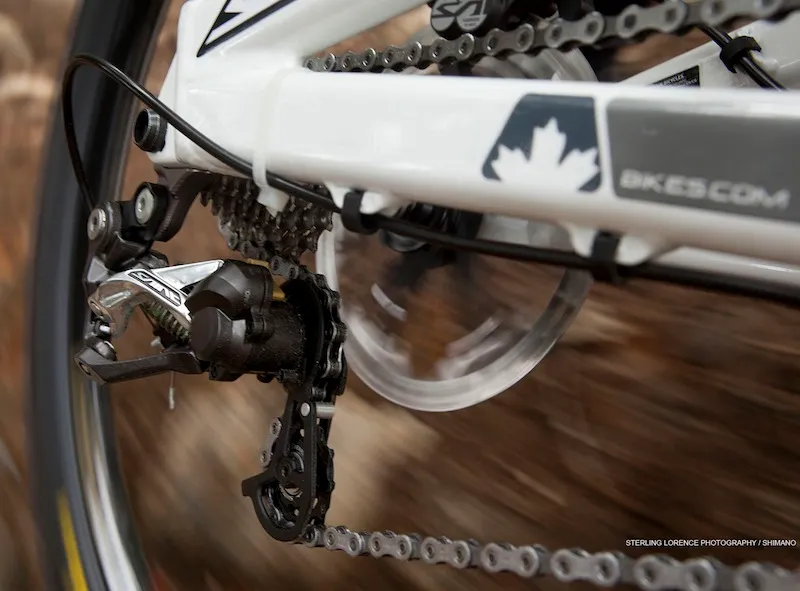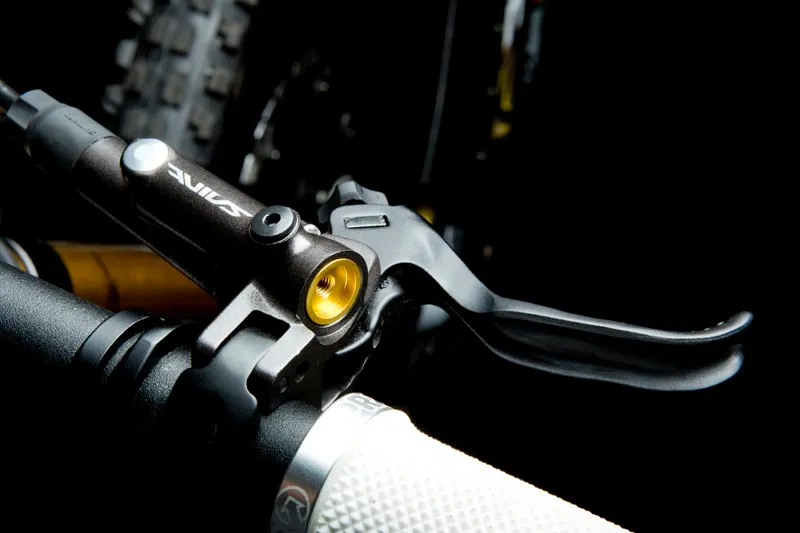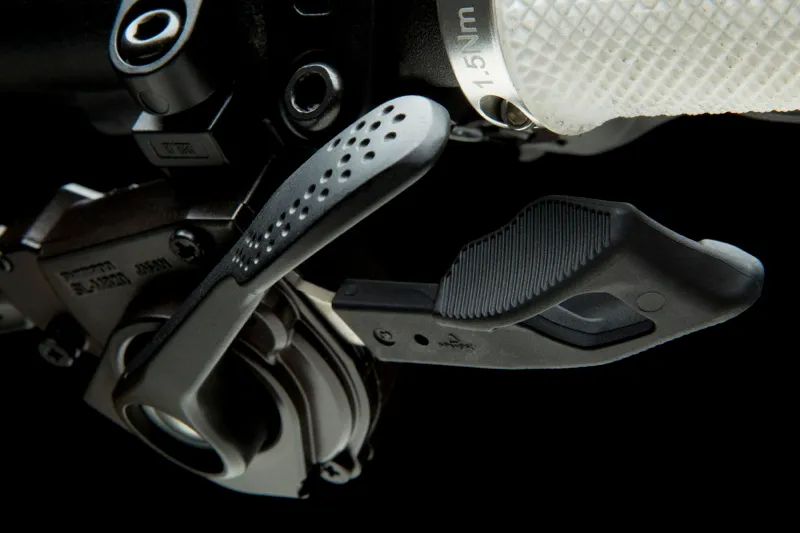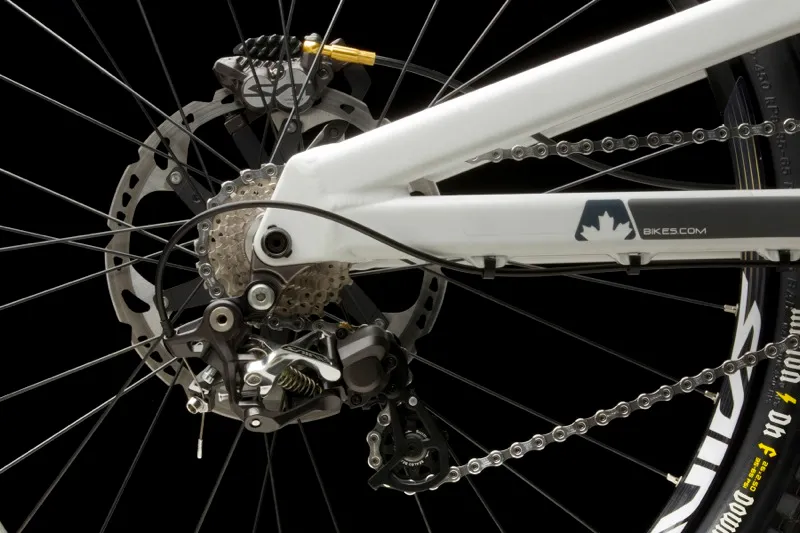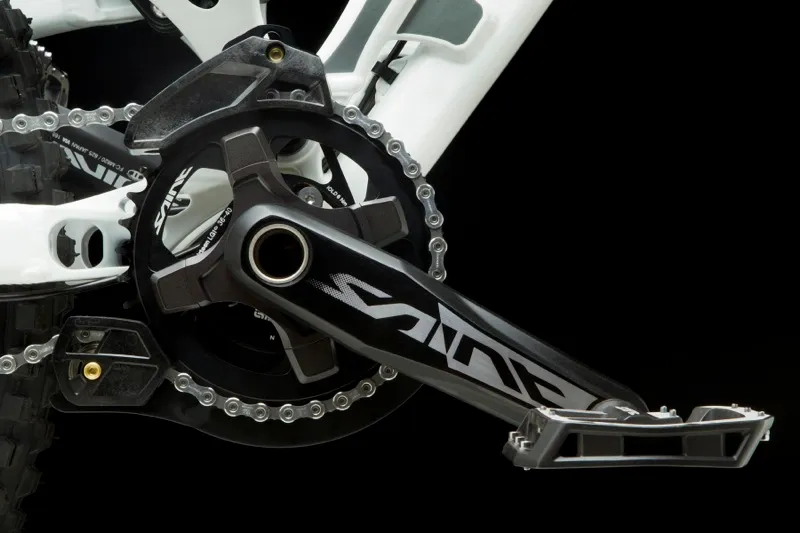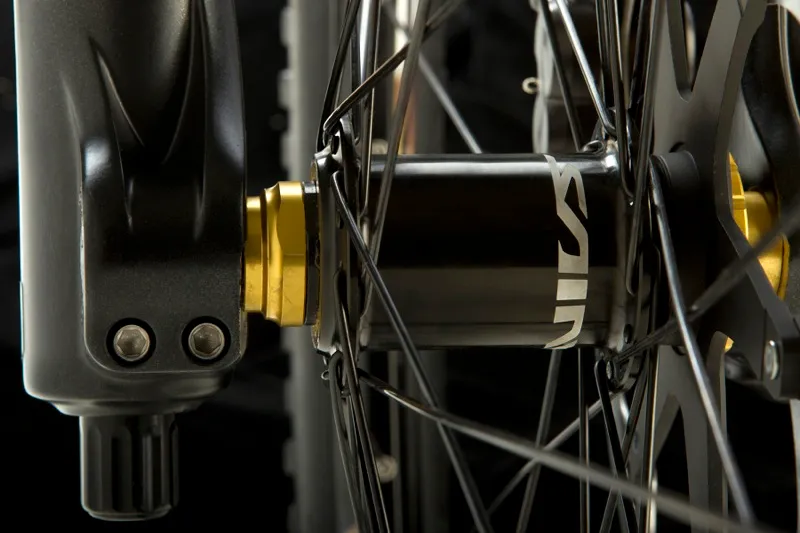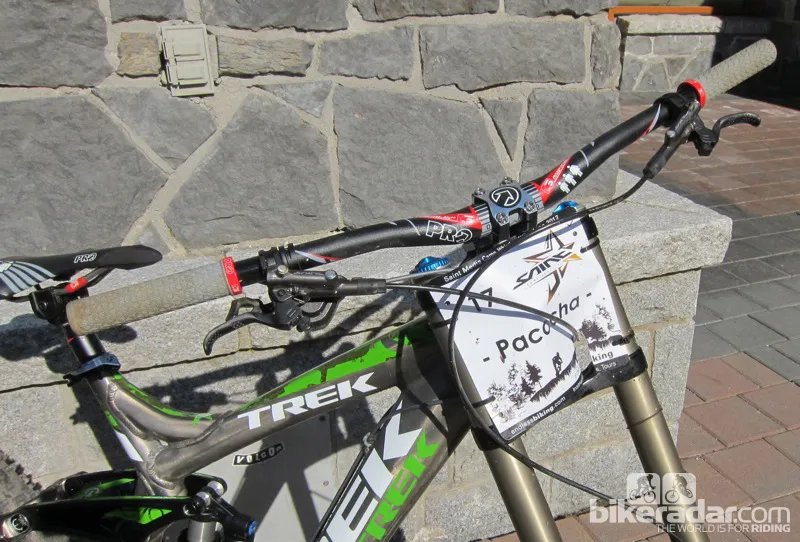Go here for our first ride review of Shimano Saint.
Shimano say their new Saint group is “pure gravity” and that it’s evolved from its focus on freeride strength to be more useful to racers as well. That means it’s lighter and more refined, but without original freeride-style options such as a double crankset.
“We’ve slowly evolved,” said Greg Hammond, Shimano America’s marketing manager. “If you start over here with downhill and over here with freeride, [you converge] and now we’re almost past each other. It’s a lot easier for the freeriders to adapt the group to what they do than it is for a downhill racer to adapt the group from what it used to be.”
“The focus with this Saint group is speed,” said Eric Doyne, Shimano’s North American PR manager.
This week BikeRadar have been at Shimano’s media camp, where the company conducted a number of breakout seminars to dive deeper into the technology and development of the new Saint set.
Here, we take a feature-by-feature look a the new group with Ben Pye, Shimano Canada’s tech specialist. He’s had the honor of representing Canada in the Olympics, as a mechanic, among other behind-the-scenes palmares.
“Everything has changed,” said Pye of the new Saint group. “It’s basically about systems management. The brakes are heat management. The derailleur is sound management. The new chain device is, basically, drivetrain management. It’s all about keeping things organized, keeping things quiet and keeping things cool, so that the rider can concentrate more on what they’re supposed to be doing: keeping the bike on the trail and getting to the finish line as fast as possible.”
Due to the latest Saint’s more downhill-specific purpose, it boasts quite a few new features. The most obvious? It’s only a 1x10 group. There’s no provision for a second chainring on the crank, and no front shifter for the M820.
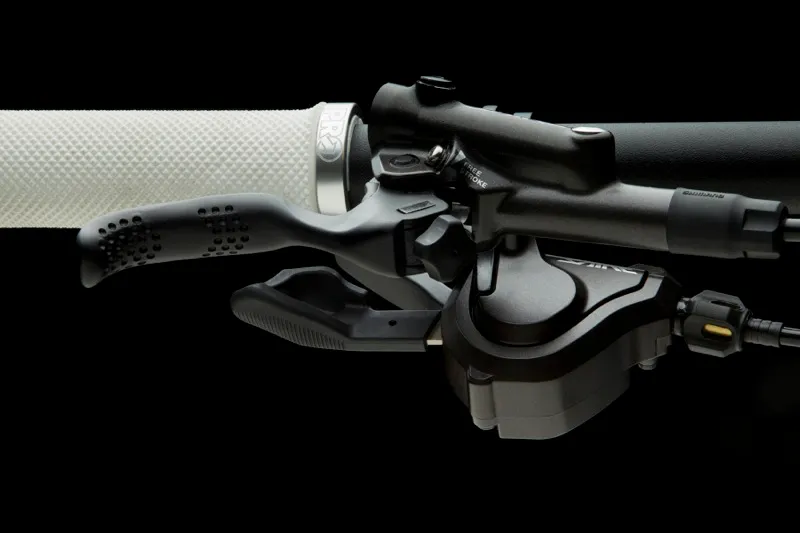
The Saint is based around a 1x10 transmission so only has a right-hand shifter
Brakes: heat management
The new 820 brakes usher Ice Technologies to the Saint group. This refers specifically to the three-piece rotors. These work with multiple heat management systems, including finned pads, ceramic pistons and a 10mm increase in banjo length (30mm total), which is a specific heat sink. Pye called out the rotors as the most significant development in the new system.

Shimano’s four-piston Saint caliper, minus the RT99 rotor
The Saint version of the Ice Tech RT99 rotor takes the three-piece construction a step further by overmolding the inner aluminum layer into cooling fins that exit toward the inside of the rotor. “When that aluminum core gets squeezed together, they squeeze out a bit of aluminum, and that has a radiator fin built onto it,” said Pye. “So that controls even more of the heat and more of the temperature.”
The finned aluminum core is sandwiched by two steel braking surfaces, the outer of which is thinner and acts as a sort of wear indicator. Shimano didn’t have the rotors at the camp for testing, but Pye elaborated on their impressive stats.
He said the Saint Ice Tech rotors run 50 degrees cooler than the standard Ice Tech rotors, which are 23 degrees cooler than a standard steel model. This is said to keep braking force higher and more linear, meaning it doesn’t drop off. It also increases the durability of the pads by 20 percent, because of the lower operating temperature. It’s important to note that the Saint rotors only come in 203mm diameter but are compatible with Shimano’s M810 brakes, should you want to upgrade.

A chart plotting the running temperature and power curves of the M820 brakes versus old M810s
Pye also fielded questions about Shimano’s use of mineral oil versus DOT fluid: “Mineral oil isn’t affected in the same way as DOT. Mineral oil is hydrophobic, so dry DOT fluid has a higher boiling point than mineral oil. But DOT fluid is always absorbing moisture out of the air, so it’s never at that [ideal dry state]. Mineral oil will actually control this heat better.”
He attributed the new Saint’s quiet brake performance to the new pad compounds, but also to a ‘toe in’ effect caused by the two different diameter pistons. He also pointed out that the pistons are ceramic, which plays a role in managing brake heat – like a coffee cup, it’s an excellent insulator, keeping heat away from the brake fluid.
Transmission: Noise management
“Saint didn’t necessarily go 10-speed [for the sake of going 10-speed],” said Pye. “Saint went Dyna-Sys so that it could be compatible with some of the other stuff that’s out there [cassettes and chains, primarily]. Dyna-Sys happens to be 10-speed.”
Though Saint is built as a 10-speed group, Shimano have designed the derailleur with extra-long limit screws, so that the system can be ratcheted down to accommodate a five-speed cassette. The rear derailleur’s clutch can be adjusted to compensate for wear or to reduce chainstay impacts, and even the B-tension has a bump stop. There is only one derailleur cage length for the new group, but Shimano have included a ‘mode converter’ on the derailleur, which allows it to work with a 34-tooth cassette cog.
“There’s a mode converter, like on the previous version,” said Pye. “But it now allows you to go to a 34-tooth cassette cog. I’ve seen a 36 on it and it seems to run fine, but according to the engineers 34 is the max. As with our other stuff, though, the engineers tend to be conservative, so officially it’s a 34.”
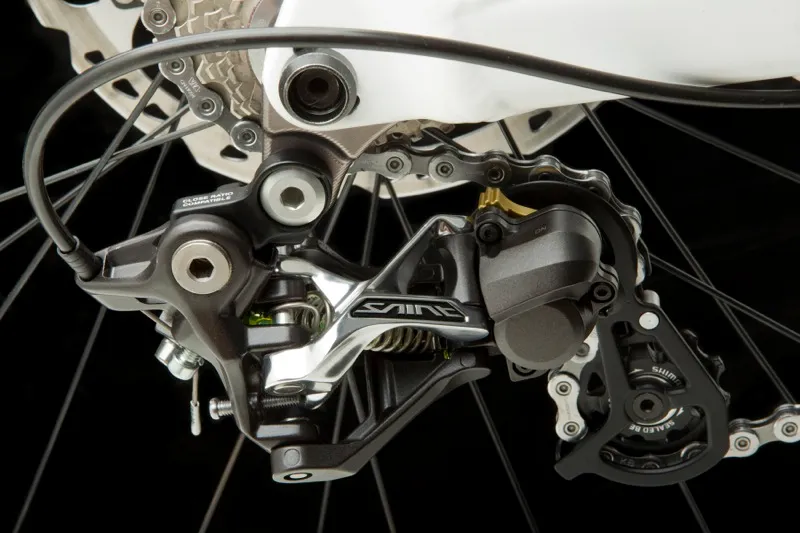
The Saint Shadow Plus rear derailleur, compatible with the new direct-mounting system or a traditional hanger
The new Saint features Instant Release (shifts as you press the lever, not when you let it go), Multi-Release (can shift more than one gear with each lever push) and 2-Way (release lever can be pushed in either direction) shifting. The levers themselves are longer, and include Vivid ergonomics (textured surfaces).
We’ve noted that the levers require noticeably less shifting effort. Shimano claim 37 percent less effort for the cable pull lever compared to the previous Saint, and 16 percent less compared to XT.
The new chainguide is meant to be ‘rider tuned’ with three bashguard options – none, one or two. It’s designed to work with a Shadow Plus rear derailleur, to create a drivetrain with a lower amount of friction overall. This is achieved by reducing the amount of wrap around the rear of the ring (compared to traditional guides) but also allowing the guide’s lower arm to swing up if it contacts the ground or other trail obstacles.
“Compared to a traditional chain device, with the pulley on the lower end, that pulley needs to be tucked up and out of the way, so it creates a lot of friction. The chain needs to come up and over it, and that creates a lot more friction than is typically needed,” said Pye. “What we’ve done is create one with a guide that sits on a swing that moves up and out of the way.”
The ring-mounted bash plates offer protection, as the guide itself only works to manage the chain. “You don’t actually need a bashguard all the way around the drivetrain,” said Pye. “Most people contact rocks with the pedals in the same place all the time. So we’ve designed it with zero, one or two guards on the chainring.”

Shimano’s modular bashguard system
Shimano have refined the M820 Saint crank to drop 100g from the previous version with a single-ring specific, co-forged spider. They’ve incorporated chainring nuts that follow the contours of the crank for a consistent, clean look.
Along with the cranks, Shimano will offer the option of a press-fit downhill bottom bracket. This will fit a 105.5x41mm shell, which mirrors the 85mm thread-type spec.
The Saint hubset is essentially the same apart from new logos, endcaps and a 12x142mm through-axle option. The group relies on rebuildable angular contact bearings and Center Lock rotor attachment. The rear hub offers the same 10-degree engagement as the previous Saint’s.
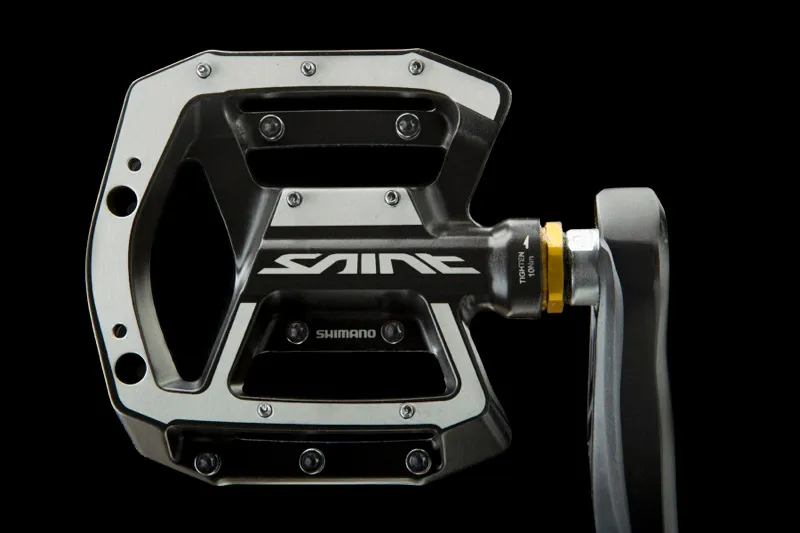
The new Saint PD-MX80 flat pedal
Finally, there are the new Saint PD-MX80 pedals. The new flats are 8.5mm shorter and 3mm wider than the previous DX PD-MX30s. They’re built with Saint-quality angular contact bearings and stainless steel spindles. “The pins are the same pins,” said Pye. “You don’t change the pins between long or short. All these pins come with a washer underneath the head, and the protrusion on the other side of the pedal is set short. If you want longer pins, you take the pin out, take the washer out and put the pin back in.”
Watch this space for BikeRadar’s first ride review of the Saint groupset.
